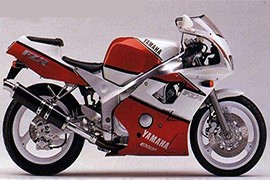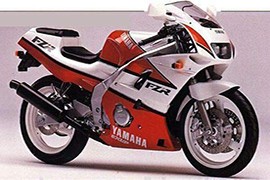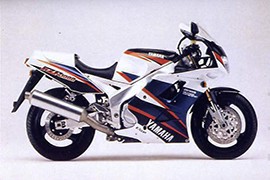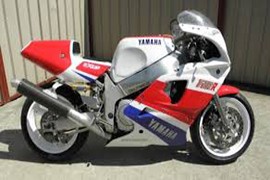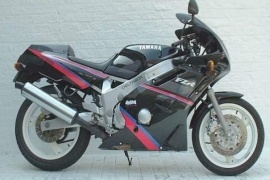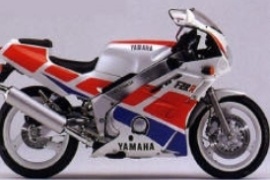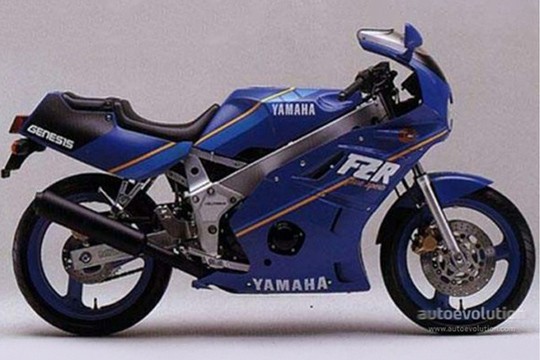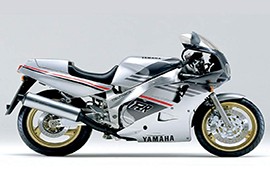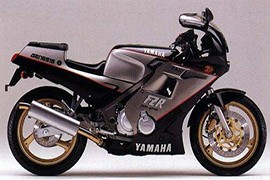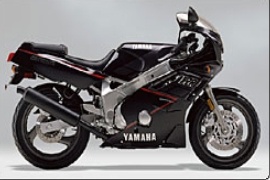YAMAHA FZR Models/Series Timeline, Specifications & Photos
First production year: 1986
The Yamaha FZR 400RR, also known as the FZR400 or FZR 400R, was a sports motorcycle manufactured by Yamaha in 1987 as a replacement model for the Yamaha FZ 400R and continued production until 1994. Over its lifetime, the bike was updated constantly every year.
In 1991, the Japanese motorcycle manufacturer launched the Yamaha FZR 400RR, a sports machine and a new model with no parts compatible with the previous models. It had an upgraded frame, and the overall design was made to ease up track-side repairs.
Visually, the 1991 motorcycle was different from previous models, packing standard features, such as a full fairing with a rectangular headlight up front, a medium-sized windscreen, a single seat with an optional pillion cover, a single exhaust system, a side stand, and three-spoke lightweight wheels.
An aluminum Deltabox frame was the mounting point for all bits and pieces, including a 41 mm telescopic fork on the front and a preload-adjustable shock absorber on the rear, delivering excellent suspension performance and handling.
As for the stopping power, the bike relied on two 298 mm brake discs tied to dual-piston calipers on the front wheel and a 210 mm disc engaged by a two-piston caliper on the rear wheel, providing optimum braking performance.
The 1991 Yamaha FZR 400RR had its heartbeat set by a 399cc four-stroke four-cylinder liquid-cooled engine, delivering 66 hp with maximum strength at 12,500 rpm and 39 Nm (29 lb-ft) torque at 9,500 rpm.
In 1986, the Japanese motorcycle manufacturer launched the Yamaha FZR 250, a smaller version of the larger FZR 400 model. The FZR 250 motorcycle was manufactured between 1986 and 1994 and was intended for the Japanese market.
In 1990, the Japanese motorcycle manufacturer launched the Yamaha FZR 250R, a sports motorcycle dressed in a full fairing, delivering excellent performance matched by great handling capabilities.
Visually, the bike packed standard features, such as a full fairing covering the power plant, a medium-sized windscreen, a single seat with an optional passenger cover, a single exhaust system mounted on the right side, and three-spoke lightweight aluminum wheels.
The bike was manufactured around a steel frame with a 38 mm telescopic fork on the front and a preload-adjustable shock absorber on the rear, offering optimum handling and suspension performance.
The bike rolled out from the factory on 17-inch wheels, with two 285 mm discs coupled to four-piston calipers on the front and a 210 mm disc with a dual-piston caliper on the rear, providing excellent braking power.
As for the power figures, the 1990 Yamaha FZR 250R had installed a 249cc four-stroke four-cylinder liquid-cooled engine underneath its fairing, fed by four Mikuni carburetors, delivering an output power of 45 hp with a peak force at 14,500 rpm and 25 Nm (18-lb-ft) torque at 11,500 rpm.
The Yamaha FZR 1000 was a sports motorcycle produced by Yamaha in 1987 to replace the Yamaha FZ 750. It continued production until 1995 when it was replaced by the Yamaha YZF 1000R Thunderace.
In 1989, the Japanese motorcycle manufacturer launched the Yamaha FZR 1000 EXUP, a sports motorcycle part of the second generation, marking a step further into the high-perfection supersport world.
The 1989 EXUP model was fitted with standard features, such as a full fairing with a dual round headlight system, a medium-sized windscreen, a single seat with a passenger seat cover, a four-into-one exhaust system, and three-spoke lightweight wheels.
The bike's base was a diamond-shaped Deltabox frame with a 43 mm adjustable telescopic fork on the front, offering 120 mm of travel, and an adjustable single shock absorber on the rear with 130 mm of travel, delivering excellent suspension performance and handling.
The braking system comprised two 320 mm discs tied to four-piston calipers on the front wheel and a 267 mm disc with a single-piston caliper on the rear wheel, providing excellent stopping power.
As for the power figures, the 1989 Yamaha FZR 1000 EXUP had installed a 1,002cc four-stroke four-cylinder liquid-cooled engine that delivered an output power of 145 hp with a peak force at 10,500 rpm and 107 Nm (79 lb-ft) torque at 8,500 rpm.
In 1989, the Japanese motorcycle manufacturer launched the Yamaha FZR 750R OW01, a sports motorcycle that debuted in 1987. The OW01 wording was the code name used during development, which remained on the production bike.
The Yamaha FZR 750R, also known as OW01, was a sports machine made by Yamaha from 1987 to 1992 in limited production to gain approval for the Superbike World Championship. The bike was replaced by the YZF 750 model in 1992.
The bike's appearance was represented by standard fittings, such as a full fairing, a dual round headlight system, a small windscreen, a single seat with lumbar support, an up-swept exhaust system, and lightweight three-spoke aluminum wheels.
The bike was built around a twin-spar aluminum frame with a 43 mm fully adjustable telescopic fork on the front and a fully adjustable Ohlins shock absorber on the rear, delivering excellent suspension performance and handling.
The braking power was handled by two 280 mm discs coupled to four-piston calipers on the front wheel and a 177 mm disc with a dual-piston caliper on the rear wheel, providing excellent stopping power.
In the performance department, the 1989 Yamaha FZR 750R OW01 had its soul brought to life by a 749cc four-stroke four-cylinder liquid-cooled engine fed by four Mikuni carburetors. The engine boasted 121 hp with a peak force at 12,000 rpm and 70 Nm (51 lb-ft) torque at 9,000 rpm.
The Yamaha FZR 600 was a sports motorcycle manufactured by Yamaha in 1988 to replace the Yamaha FZ 600. It continued production until 1995 when it was replaced by the Yamaha YZF 600R.
It packed a steel Deltabox frame and swingarm similar in design to the aluminum Deltabox frame of the FZR 400 model introduced three years earlier. The engine was slanted forward in the frame for a centralized mass and a lower center of gravity.
In 1989, the Japanese motorcycle manufacturer launched the Yamaha FZR 600, a sports motorcycle with standard fittings, such as a full fairing with two round headlights, a medium-sized windscreen, a single seat with a passenger seat cover, an up-swept single exhaust system, and lightweight three-spoke wheels.
Suspension-wise, the bike packed a 41 mm adjustable telescopic fork on the front, delivering 130 mm of travel, and an adjustable shock absorber on the rear with 115 mm of travel, offering optimum suspension performance and handling capabilities.
The braking performance was achieved by two 298 mm discs coupled to dual-piston calipers on the front wheel and a 214 mm disc with a single-piston caliper on the rear wheel, providing excellent stopping performance.
As for the power figures, the 1989 Yamaha FZR 600 had installed a 599cc liquid-cooled four-stroke four-cylinder engine underneath its fairing, delivering 91 hp with maximum strength at 10,500 rpm and 65 Nm (48 lb-ft) torque at 8,500 rpm.
The Yamaha FZR 400 was a sports motorcycle made by Yamaha in 1987 to replace the Yamaha FZ 400R and continued production until 1994. The bike was updated yearly until 1994, when its production ended.
In 1989, the Japanese motorcycle manufacturer launched the Yamaha FZR 400, a sports motorcycle fitted with standard features, such as a full fairing with dual round headlights, a medium-sized windscreen, a two-piece dual seat, an up-swept single exhaust system, and lightweight three-spoke aluminum wheels.
The bike was manufactured around an aluminum Deltabox frame with a 41 mm telescopic fork on the front and a preload-adjustable shock absorber on the rear, providing optimum suspension performance and handling.
The bike rolled on a 17-inch front wheel with two 298 mm discs engaged by dual-piston calipers and an 18-inch rear wheel with a 210 mm disc with a dual-piston caliper, delivering excellent stopping power.
As for the power figures, the 1989 Yamaha FZR 400 had its heartbeat set by a 399cc four-stroke four-cylinder liquid-cooled engine that delivered 59 hp with a peak force at 12,000 rpm and 37 Nm (27 lb-ft) torque at 10,000 rpm.
The engine power was handled by a six-speed manual transmission with a wet multi-plate clutch and delivered to the rear axle through a final chain drive, pushing the motorcycle to 196 kph (122 mph).
The Yamaha FZR 400 was a sports motorcycle manufactured by Yamaha from 1987 as a replacement for the Yamaha FZ 400R and continued production until 1994 when production ended. In addition, until 1994, the bike was constantly updated every year.
All FZR 400 models were powered by 399cc naturally aspirated, carburated, and liquid-cooled engines. The power units were transversally mounted in an aluminum perimeter box-section-type Deltabox frame, which was quite a unique layout at the time.
The 1984 Yamaha FZR 400 had its thrust from a 399cc four-stroke liquid-cooled four-cylinder engine mounted underneath its full fairing, boasting 59 hp with a peak force at 12,000 rpm and 37 Nm (27 lb-ft) torque at 10,000 rpm.
The engine was bolted to a six-speed manual transmission with a wet multi-plate clutch, sending the power to the rear wheel through a final chain drive, pushing the motorcycle to a top speed of 198 kph (123 mph).
From top speed to a complete halt, the bike relied on a pair of 282 mm brake discs tied to dual-piston calipers on the front wheel and a 210 mm disc coupled to a two-piston caliper on the rear wheel.
The bike was built around an aluminum Deltabox frame with a telescopic fork on the front and an aluminum swingarm with a single shock absorber on the rear, delivering optimum suspension performance and handling.
The Yamaha FZR 1000 was a sports motorcycle manufactured by Yamaha in 1987 to replace the Yamaha FZ 750. It continued production until 1995 when it was replaced by the Yamaha YZF 1000R Thunderace.
The bike was characterized as the world's finest production motorcycle at the time. The 1989 model delivered 140 hp but also class-leading handling to match. Over its production period, the machine was constantly upgraded and won several awards through the 19990s.
In 1987, the Japanese motorcycle maker released the Yamaha FZR 1000 Genesis, a sports motorcycle with standard fittings, such as a full fairing with a dual round headlight system and a medium-sized windscreen, a single seat with an optional passenger seat cover, a single exhaust system, and three-spoke lightweight aluminum wheels.
The 1987 Yamaha FZR 1000 Genesis had installed a 989cc four-stroke four-cylinder liquid-cooled engine underneath its fairing, delivering 135 hp with a peak force at 10,000 rpm and 102 Nm (75 lb-ft) torque at 8,500 rpm.
The power produced by the engine was handled by a five-speed manual transmission with hydraulically-controlled wet multi-plate clutch and sent to the rear end through a final chain drive, pushing the motorcycle to 257 kph (159 mph).
As for the braking power, the bike relied on two 317 mm discs coupled to four-piston calipers on the front wheel and a 264 mm disc with a dual-piston caliper on the rear wheel.
The Yamaha FZR 750R, also known as the OW01, was a sports motorcycle manufactured by Yamaha in 1987. The bike was produced until 1992 when it was replaced by the Yamaha YZF 750. It was a race replica made in limited numbers to gain approval for the Superbike World Championship.
The bike's sales were limited to 500 units and it was developed to compete in the Superbike World Championship against the Honda VFR 750R and Ducati 851. It was characterized as an innovative and cutting-edge motorcycle at the time.
In 1987, the Japanese motorcycle manufacturer launched the Yamaha FZR 750R Genesis, a sport motorcycle with standard features, such as a full fairing, a dual round headlight system, a one-piece dual seat, a single exhaust system with a silencer mounted on the right side, and three-spoke aluminum wheels.
The bike was built around an aluminum twin-spar frame with a 41 mm Kayaba adjustable telescopic fork on the front, offering 130 mm of travel, and an adjustable Kayaba shock absorber on the rear, delivering 30 mm of travel.
The braking power was handled by two 320 mm discs with dual-piston calipers on the front wheel and a 267 mm disc with a two-piston caliper on the rear wheel, offering excellent stopping performance.
As for the power figures, the 1987 Yamaha FZR 750R Genesis had installed a 749cc four-stroke four-cylinder liquid-cooled engine that delivered an output power of 106 hp at 10,500 rpm and 72 Nm (53 lb-ft) torque at 8,250 rpm.
In 1986, the Japanese motorcycle maker introduced the Yamaha FZR 250, the smaller version of the larger FZR 400 model. The FZR 250 machine was manufactured between 1986 and 1994 and was intended for the Japanese market.
The bike came fully dressed in an all-covering fairing and packed with standard features, such as a dual round headlight system, a medium-sized windscreen, a two-piece dual seat, a four-into-one exhaust system, and lightweight three-spoke aluminum wheels.
The bike was manufactured around a steel frame with a telescopic fork on the front and a single shock absorber on the rear, delivering optimum suspension performance and handling capabilities.
As for the stopping power, the motorcycle relied on a 320 mm disc tied to a four-piston caliper on the front wheel and a 210 mm disc with a dual-piston caliper handling the rear wheel, providing excellent braking performance.
In the performance department, the 1986 Yamaha FZR 250 had its soul brought to life by a 249cc four-stroke four-cylinder liquid-cooled engine, delivering an output power of 45 hp with maximum strength at 14,500 rpm and 25 Nm (18 lb-ft) torque at 11,500 rpm.
All the power produced by the power unit was handled by a six-speed manual gearbox with a wet multi-plate clutch, sending it to the rear axle through a final chain drive.
